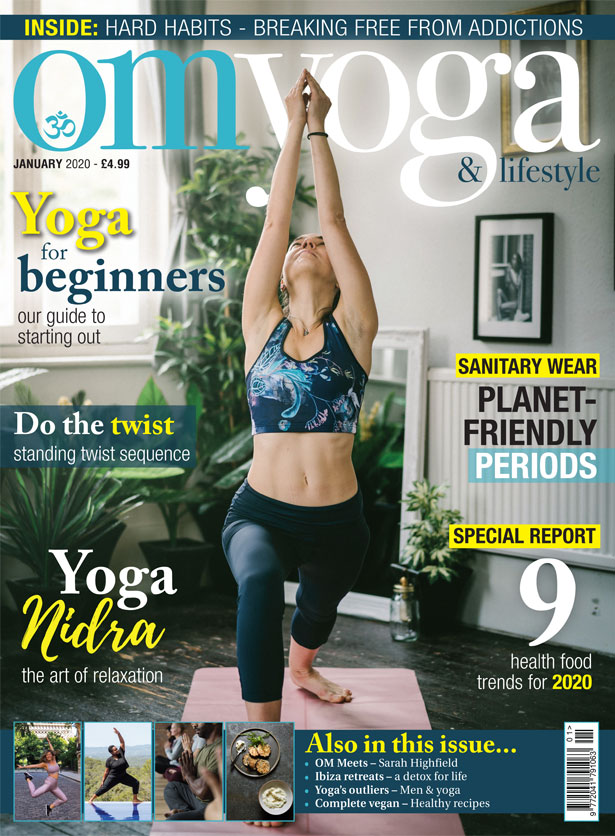
Yoga philosophy for teens and tweens
Introducing elements of the Yamas and Niyamas spiritual code for teenagers and pre-teens. By Kerry Curson
The great beauty of yoga’s ancient texts is that the wisdom held within the prescriptions, myths and legends still speak to us today because they ultimately contain lessons for all humanity. As human beings we all experience times of inner turmoil; difficulties that we struggle to navigate and relationships that uplift us, and others that drain us. Lessons in each of these areas can be found within the texts of yoga when we take the time to study them; self-study being one of the Niyamas, or Svadhyaya. In modern yoga classes where time is limited and movement in demand, the Yamas and Niyamas offer simple advice on living a wholesome and contented life. They offer simple messages that can be pared down into self-reflective exercises encouraging personal growth during our practice on the mat. Such exercises are particularly powerful for tweens and teens, who naturally find themselves in times of great change physically and emotionally, which can magnify any sense of inner turmoil. The teenage years are a magnificent time of unfolding, but also strange and confusing. Having a clear focal point on which to direct any emotional stirring and unease can offer a sturdy anchor to hold on to during this tumultuous period in life.
THE YAMAS AND NIYAMAS
The Yamas consist of the following:
Ahimsa - Non-violence
Satya - Truthfulness
Asteya - Non-stealing
Brahmacharya - Sexual restraint
Aparigraha - Non-attachment
The Niyamas are:
Saucha - Purity
Santosha - Contentment
Tapas - Discipline
Svadhyaya - Study
Isvara Pranidhana - Surrender to grace
High stakes
Teenagers are under greater pressure than ever, in fact almost as much as adults in many ways. They are told that they must be successful academically in order to have a chance at survival in a world that they still don’t have the full capacity, or experience to completely understand. This lack of understanding and a misunderstanding of success imparted from our culture can be the cause of great stress and anxiety. At a time in history when teenage anxiety and depression is at an all time high, schools are now receiving additional budgets towards wellbeing classes as part of their physical education curriculum; recognising the importance of mindfulness, meditation and yoga practices. In a fast-paced world of constant change and evolution it has perhaps never been more necessary to empower the next generation to find value from within, where all else is pulling their attention outward in search of what our society defines as ‘success’. Success, for most of us, has been portrayed as having or accumulating. Having money, houses, cars, good jobs, perfect relationships — all things of the material that many find over and over leave them still feeling empty and wanting. Perhaps youngsters are cottoning on to the emptiness of it all and so find themselves in search of something not on offer in traditional media and education. This is where the yoga teacher can have an incredible influence on the emotional wellbeing of young students.
Yoga for teens
If you’ve ever taught a teenage yoga class you’ll know already that it is challenging, and if you haven’t, I can confirm it is challenging — but also one of the most rewarding classes I teach. Whether it’s an area of teaching you are considering for the first time or already well seasoned in and just wanting inspiration you will hopefully find it. Teenager yoga classes can be the place where youngsters come to redefine success, as it is formerly known. As a by-product they can build self-confidence, self-assurance and compassion. Yoga can offer this not simply in the form of pure asana but by cleverly weaving in some of yoga’s ancient philosophy that can help make sense of a world that has always been challenging. Now, of course, our modern challenges are worlds away from those of history, but the essence of peace and happiness remain the same, which is why yoga has become such a timeless practice for navigating life.
Introducing the Yamas & Niyamas
The ethical guidelines of yoga ensure that we come from a place of right attitude. The Yamas relate to our interactions with the outer world and the Niyamas are attitudes that refer to our relationship with our inner world. When planning to introduce these to any class theme — but particularly to teenagers who are even more challenging to keep engaged in an environment where there is so much demand on them intellectually all day — it is important to make any class theme engaging and relatable. Do you practice Satya (truthfulness), Ahimsa (non-violence) and Antosha (contentment)? You probably do either actively or inadvertently. Most of us do to an extent unconsciously. However, to consciously practice them deepens the level on which we experience and feel them. Consider how you practice these already and why? How do these practices or ideals help you? Could you do with more discipline in your life (Tapas) or do you impose too much on yourself and feel that you could be a little kinder to yourself? This circles us back to Ahimsa or non-violence in the form of self-compassion. The best advice I ever received regarding class theming is to first personalise: consider how that theme, philosophy or inspirational quote has affected or enhanced your life, and then universalise i.e. how might this help others in the same way? Taking some time at the start of class to open your heart to your students and tell them how an area of yoga philosophy has helped you is the ‘personalise’ part; it also helps students connect with you as a teacher on a deeper level. To ‘universalise’ you can explain briefly how the same idea or philosophy can help others. This is a great way of fully engaging and connecting, especially with teenagers who may find that they feel worlds away from adults in their outlook on life.
Class ideas
These may not all be relevant or appropriate to a teenage class but here are a few ways that you might cleverly weave some of the attitudes and lessons of the Yamas and Niyamas into a yoga class for teens. They offer the opportunity for youngsters to build a strong inner compass of strength and kindness as they navigate life’s challenges. A beautiful way to explore Ahimsa or non-harming as a means to first encourage self-compassion and compassion towards others is a simplified compassion meditation kept succinct in five steps that can be completed in five minutes.
1. Consider someone that you easily feel a great sense of unconditional love for. Imagine hugging them and send them kindness.
2. Move onto someone you like and do the same thing.
3. Move onto someone that you are not so familiar with but say ‘hi’ to in passing. Send them your kindness.
4. Think of someone you have a difficult relationship with and send them kindness too. Whatever comes up here, observe it without suppression. You may not find it within yourself to send them kindness today but with practice you might in future.
5. Imagine meeting yourself in the street. See yourself as you do through your eyes, and whatever comes up send yourself kindness.
To intentionally practice compassion is scientifically proven to spark the neurons in the brain that experience this great sense of kindness and it can be really useful to delve into this with teenagers that find themselves very outwardly focused, especially with the draws of social media. Compassion can mean that we all use these tools in more conscious ways.
Journaling exercise
Satya or truthfulness can be an incredibly empowering element of yogic lifestyle for teenagers to contemplate. A simple journaling exercise might have them feeling a great sense of emotional freedom at a junction in their life where they may feel more restricted than they would like, and perhaps a greater burden of self-filtering than in the past. Vedanta Yoga recognises you as the embodiment of truth, bliss and consciousness. On introducing this idea share a time that you may have said one thing and felt another…why? In life there is the truth that the stone falls to the floor if you drop it, and then there is your truth, which is that you might like maths but hate science; there is no right or wrong to this, it is just your truth. However, sometimes we have to say one thing, think another and do another just to fit in. This can be said for adults and teenagers alike. A journaling exercise can be a really effective means for self-contemplation on this. Offer these points to consider:
1. Make a note of things that you say that you don’t mean or don’t completely believe, but you say them anyway to please someone else.
2. Notice if you ever think one thing, say another and act in a third way.
3. Are your thoughts and actions in alignment?
4. Do not worry about the answers, but simply set yourself the task to bring your thoughts, words and actions into alignment in practice for a week and see how this makes you feel. Such contemplations can help all of us find our voice when sometimes we feel it a struggle to do so.
Gratitude practice
Santosha or contentment is another area that can be explored in a really simple but powerful way. For teenagers, discontent can stem from the need to constantly keep up with the crowd in terms of what to wear, where to hang out and what to be into. A gratitude practice can be very grounding and act as the pull back into the privileged reality that most of us live in. For this, you would simply set a task at the beginning or end of the class (or both), for students to note five things that they are thankful for, and then set the task for them to try and do this every day for at least a week. This is another area that builds in its effectiveness over time practiced as it begins to alter the mindset to focus on all that we do have instead of what we do not.
A last exercise that most of us probably avoid more than happily move towards is discipline. This is where the theory of ‘personalise’ to ‘universalise’ will be the teacher’s best friend. Consider something that you were terrible at and felt like you wanted to avoid, but on pushing yourself into practice became better at and perhaps started to even enjoy it — for many teachers, you probably have a yoga-related story right? If so, use it in a two-minute roundup and then ask students to journal or discuss (e.g. Pick something that they would like to be better at; consider what needs to be done to get better at it; what would help you to do that? Do it).
Strong foundations
This is not an exhaustive list but with practice, you can start to weave these into classes and then build on and add to them, perhaps bringing certain poses into play as physical manifestations of what you have discussed or contemplated earlier. Self-awareness exercises such as these can turn an exercise class into a spiritual journey that will go on to last a lifetime and build strong and contented human beings.
The teenage years are the third most transformational stage for the brain. Teenagers have an innate sense of needing to belong outside of their family unit and to experience new things and take new risks. It is at this stage that the once innocent child suddenly becomes like a stranger to the parent and feel more alienated from their teachers as they feel discipline impose itself on them just as they get a sense of wanting to spread their wings. It is for this reason that teens and tweens can seem lost to themselves as well as those closest to them. Yoga can become their safe space to experience all of this without fear of judgement and suppression. Yoga’s philosophy will provide them with strong support on how to navigate this time as a magnificent expansion with more ease, strength and grace.
Kerry Curson is a yoga instructor teaching across the West Coast of Wales





